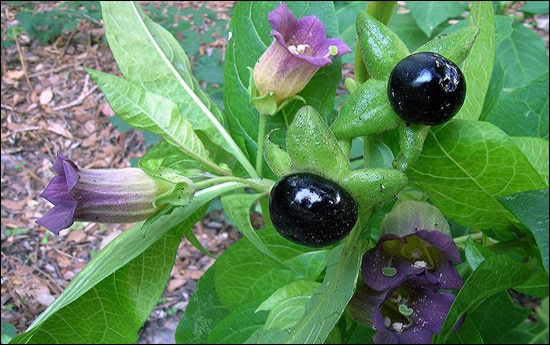Angurshafa / Soochi / Atropa belladonna – Classification, Ayurvedic Properties & Dosage
Description
Belladonna is native to Eurasia. It is a kind of short herb with beautiful flowers that is bell-shaped, red coloured and gives fruits of Jet black colour. This shrub is very useful when used as its leaf because it gives a stronger and safer effect than the root, the seeds and the fruit of this shrub must be avoided because they can cause ill effects and atropine, hyoscyamine, and hyoscine (scopolamine), tropane alkaloids are the major chemical components of this shrub with these constituents this herb is called as more potent.

General Information
Atropa belladonna has a perennial herbaceous plant of the nightshade family Solanaceae which grows relatively in Europe, North Africa, and western Asia. If this product is used in a disturbing dosage then it may show some serious side effects like Seizures, problems related to the respiratory system, constipation or bloating, and Urinary tract illness and agitation and constipation are also seen so this herb must be used carefully to avoid these kinds of ill effects. Belladonna is mainly used as a sedative herb so physicians recommend this herb in Asthmatic patients and those with whooping cough with cold or hay fever. It is also used in many Vataj disorders, like Parkinsonism, Irritable bowel syndrome, or is beneficial for its analgesic properties.
Special Note About This Plant
Belladonna is a plant, its roots and roots are used to prepare medicines, it is also called the deadly nightshade and is used in Ayurvedic and homoeopathic medicines. Belladonna means Beautiful lady, especially in Italy. The juice of Belladona berry was used in ancient times to enhance the size of pupils of females, and give them a beautiful resonance that helps them to attract people towards them. But it is not a good idea to use this herb for attractive purposes because it may cause ill effects.
Systemic Classification
- Botanical Name – Atropa belladonna
- Family – Solanaceae
Other Vernacular Names
- In Hindi – Saag angur, angur shafa
- In Punjabi – Soochi
- In Bengali – Yebrooj
- In Bombay – Girbuti
- In Kannada – Jhallakphala
Habitat
- The size of the shrub is 4 to 5 ft long.
- Leaves are 3 to 8 inches long with sharp edges and are thinner on the downside. These are simple and deciduous and are ovate in shape.
- Its Fruits are black in colour and sparkly in nature. It consists of 10 to 20 seeds.
- Its Roots are long up to 1 feet and are 1 to 2 inches thick and swollen and tender.
- Its Flowers are of pale lavender in colour 6-12 mm long and rise from June to July with solitary pendant auburn flowers and they are campanulate and double in nature.
This is basically found in middle and southern European areas but in India, in some hilly areas, it can be found wildly like in Kashmir valleys.
Classical Categorisation
- Raj nighantu – They consider that either morphological variation in the Dhatura genus or Atropa belladonna, these have similar features that might have taken by same varieties as Dhatura in Raj Nighantu.
Ancient Verse

Reference – Dravyaguna vibhaga
Ayurvedic Properties
- Rasa (Taste) – Tikta (Bitter), Katu (Pungent)
- Guna (Quality) – Laghu (Light), Ruksha (Dry)
- Veerya (Potency) – Ushna (hot)
- Vipaka (Post digestive effect) – Katu (Pungent)
- Karma (Action) – Balances the Kapha and vata dosha and enhances the Pitta dosha.
- Projyang (Part used) – Leaf, roots of this plant can be used.
Effects on Doshas
- Due to its ushna potency, it is very effective in Kapha vata pacification and slightly enhances the pitta dosha.
Practical Uses
- This can be used in Kapha-vata disorders.
- This is locally applied to the inflamed areas, and in arthritic patients in cervical spondylosis where inflammation lies in the joints, we can use this shrub as its oil or paste form.
- This is the perfect herb for relieving pain.
- This herb has acetylcholine binding capacity with muscarinic receptors, that’s why it reduces smooth muscle activity and effectively decreases the gastric and pancreatic juices to develop, so it is efficiently used to treat the peptic ulcers or GERD condition.
- Excessive salivation can be reduced by this herb.
- Cough, respiratory distress, asthma, and bronchitis can be relieved by this herb, which works due to its Kapha-vata har properties.
- Its leaves are also used against diabetes and also help in all urinary tract-related disorders.
- Excessive sweating over the tight parts of the body can be reduced with this herb.
- This is an anti-poisoning herb for ahiphena (Papaver somnifera), and vatsnabh (Aconitum Ferox) type poisons.
- Due to its ushna potency and ruksha gunna it is good for eliminating itching and excessive sweating.
- In modern medicines, belladonna is generally combined with other herbs to see its results in peptic ulcers effectively and even Helicobacter pylori infection can be cured with this herb.
Dosage
- In powder form, 30 to 60 mg can be used.
With a high dosage, adverse effects are commonly observed like dilatation of pupils, flushed skin with increased nervousness, and repeatedly increased thirst with dryness in the mouth.
confusion, delirium, tachycardia, and lethargy can occur if you have got very high dosage of this herb.
Contraindicated
These patients are suffering from glaucoma, benign prostatic hyperplasia, megacolon, and arrhythmias are highly contraindicated to taking this medicinal herb because it can worsen their ongoing condition.



